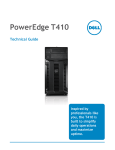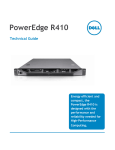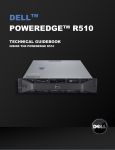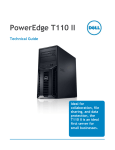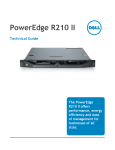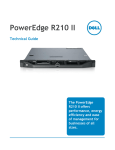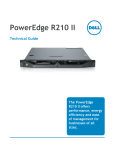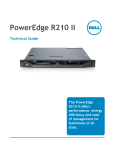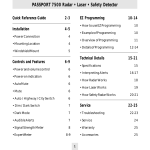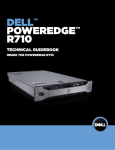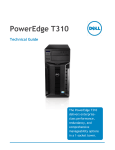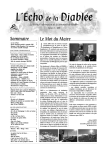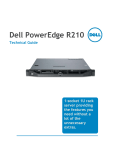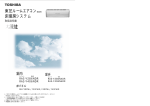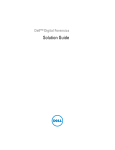Download DELL PowerEdge T410
Transcript
PowerEdge T410 Technical Guidebook DELL TM POWEREDGE T410 TM TECHNICAL GUIDEBOOK INSIDE THE POWEREDGE T410 Dell PowerEdge T410 Technical Guidebook Table of Contents 1 Product Comparison................................................................................................................... 1 1.1 2 Overview/Description ........................................................................................................... 1 New Technologies ...................................................................................................................... 3 2.1 3 New Technologies Used in the PowerEdge T410................................................................. 3 System Overview ....................................................................................................................... 3 3.1 3.2 4 Overview/Description ........................................................................................................... 3 Product Features Summary ................................................................................................. 4 Mechanical ................................................................................................................................. 7 4.1 4.2 4.3 4.4 4.5 4.6 4.7 4.8 4.9 4.10 4.11 4.12 Chassis Description ............................................................................................................. 7 Dimensions and Weight ....................................................................................................... 7 Front Panel View and Features ............................................................................................ 8 Back Panel View and Features .......................................................................................... 11 Power Supply Indicators..................................................................................................... 12 NIC Indicators .................................................................................................................... 12 Side Views and Features ................................................................................................... 13 Internal Chassis Views ....................................................................................................... 14 Rails and Cable Management ............................................................................................ 16 Fans ................................................................................................................................... 17 Control Panel/LCD ............................................................................................................. 17 Security .............................................................................................................................. 17 4.12.1 4.12.2 4.12.3 4.12.4 4.12.5 4.12.6 4.12.7 4.13 4.14 4.15 5 Cover Latch................................................................................................................. 17 Bezel ........................................................................................................................... 19 Hard Drive ................................................................................................................... 19 Trusted Platform Management .................................................................................... 20 Power-Off Security ...................................................................................................... 20 Intrusion Alert .............................................................................................................. 20 Secure Mode............................................................................................................... 20 USB Peripherals................................................................................................................. 20 Battery ............................................................................................................................... 21 Field Replaceable Units (FRU) ........................................................................................... 21 Electrical .................................................................................................................................. 22 5.1 5.2 6 Volatility ............................................................................................................................. 22 ePPID ................................................................................................................................ 22 Power, Thermal, and Acoustic .................................................................................................. 23 6.1 6.2 6.3 6.4 6.5 6.6 7 8 Power Supplies .................................................................................................................. 23 Power Supply Specifications .............................................................................................. 24 Environmental Specifications ............................................................................................. 26 Maximum Input Amps......................................................................................................... 27 Energy Star Compliance .................................................................................................... 27 Acoustics............................................................................................................................ 27 Block Diagram .......................................................................................................................... 28 Processors ............................................................................................................................... 31 8.1 Dell Overview ............................................................................................................................ 31 PowerEdge T410 Technical Guidebook 8.2 8.3 8.4 8.5 8.6 8.7 8.8 8.9 9 Supported Processors ........................................................................................................ 31 Processor Configurations ................................................................................................... 32 Processor Installation ......................................................................................................... 33 Overview/Description ......................................................................................................... 33 DIMM Types Supported ..................................................................................................... 33 Slots/Risers ........................................................................................................................ 33 Mirroring ............................................................................................................................. 34 RAID .................................................................................................................................. 34 Chipset ..................................................................................................................................... 34 9.1 10 Overview/Description ......................................................................................................... 34 BIOS ........................................................................................................................................ 35 10.1 10.2 10.3 10.4 11 Overview/Description ......................................................................................................... 35 Supported ACPI States ...................................................................................................... 36 11G BIOS Power Management .......................................................................................... 36 I2C (Inter-Integrated Circuit) ............................................................................................... 37 Embedded NICs/LAN on Motherboard (LOM) .......................................................................... 37 11.1 12 Overview/Description ......................................................................................................... 37 I/O Slots ................................................................................................................................... 38 12.1 12.2 12.3 13 Overview/Description ......................................................................................................... 38 Quantities and Priorities ..................................................................................................... 38 Boot Order ......................................................................................................................... 39 Storage .................................................................................................................................... 39 13.1 13.2 13.3 13.4 13.5 13.6 13.7 14 14.1 15 15.1 16 17 18 18.1 19 19.1 19.2 19.3 19.4 19.5 19.6 20 Dell Overview/Description ......................................................................................................... 39 Drives ................................................................................................................................. 40 RAID Configurations .......................................................................................................... 40 Storage Controllers ............................................................................................................ 42 LED Indicators ................................................................................................................... 42 Optical Drives ..................................................................................................................... 42 Tape Drives........................................................................................................................ 42 Video ........................................................................................................................................ 42 Overview/Description ......................................................................................................... 42 Audio ........................................................................................................................................ 43 Overview/Description ......................................................................................................... 43 Rack Information ...................................................................................................................... 43 Operating Systems ................................................................................................................... 43 Virtualization ............................................................................................................................ 45 Overview/Description ......................................................................................................... 45 Systems Management.............................................................................................................. 45 Overview/Description ......................................................................................................... 45 Server Management........................................................................................................... 46 Embedded Server Management......................................................................................... 46 Lifecycle Controller and Unified Server Configurator .......................................................... 46 iDRAC Express .................................................................................................................. 47 iDRAC6 Enterprise ............................................................................................................. 47 Peripherals ............................................................................................................................... 49 PowerEdge T410 Technical Guidebook 20.1 20.2 21 Dell USB Peripherals................................................................................................................. 49 External Storage ................................................................................................................ 49 Packaging Options ................................................................................................................... 49 PowerEdge T410 Technical Guidebook 1 Product Comparison 1.1 Overview/Description The PowerEdge T410 is a two-socket tower server that delivers the most flexible configuration options to fulfill different business and customer needs and maximize their IT budget. T410 provides: • • • • • • Up to 2 sockets of Intel Xeon 5500 series processors. Dell’s Lifecycle Contoller available via optional iDRAC Express or iDRAC Enterprise Competitive security features with TPM, internal USB and IPv6 Competitive storage expandability and with up to 6 x 3.5” hard disk drives Excellent serviceability and diagnostics with optional interactive LCD A chassis depth of only 24” for deployment flexibility. Table 1. Comparison of T410 to T605 and T610 Feature/Spec T410 T605 (Predecessors) T610 (Next level up) Processor 2S Intel® Xeon® processor 5500 series AMD Opteron 2XXX series 2S Intel Xeon processor 5500 series Front Side Bus QPI @ 6.4 GT/s 1GBz HyperTransport QPI @ 6.4 GT/s # Procs 1 to 2 1 or 2 1 to 2 # Cores Dual or Quad Dual or Quad Dual or Quad L2/L3 Cache 4 MB or 8 MB Chipset Intel 5500 chipset HT2100 + HT1000 Intel 5520 chipset DIMMs 4+4 DDR3 Unbuffered w/ECC or Registered w/ECC 1333/1066/800MHz 8 DDR2 Registered w/ECC 667MHz 6+6 DDR3 Unbuffered w/ECC or Registered w/ECC 1333/1066/800MHz Min/Max RAM 1 GB/64 GB 512 MB/32 GB 1 GB/96 GB HD Bays 6 x 3.5” Optional Hot-swap Support 2.5" Hard disk drives via Hot-swap tray 4 x 3.5” Optional Hot-swap 8 x 2.5”/3.5” Hot-swap HD Types Default SATA. Optional SAS and SSD via add-in controller Default SATA. Optional SAS via add-in controller Default SATA or SAS Ext Drive Bay(s) 2 x 5.25” bay 2 x 5.25” bay 1x 3.5” bay 2 x 5.25” bay Embedded HD Controller Chipset based SATA Chipset based SATA SAS 6/iR 4 MB or 8 MB 1 Dell PowerEdge T410 Technical Guidebook Feature/Spec Optional Storage Controller T410 NON-RAID: SAS 5/E LSI 2032 (For TBU only) SAS 6/E RAID: SAS 6/iR Adapter PERC 6/i PERC 6/E T605 (Predecessors) SAS 5/iR SAS 6/iR PERC 6/i T610 (Next level up) NON-RAID: SAS 5/E LSI 2032 (For TBU only) RAID: SAS 6/iR (Default) PERC 6/i PERC 6/E Availability Hot-swap hard disk drives; Redundant PSU; Quadpack LED diagnostic/LCD with Hot-swap hard disk drives chassis; Memory mirroring Tool-less chassis; LCD diagnostic Hot-swap hard disk drives; Redundant PSU; LCD diagnostic; Memory mirroring or sparing; Internal SD card for embedded Hypervisor Server Mgt. BMC, IPMI 2.0 compliant; Full Open Manage suite Optional; iDRAC6 Express, iDRAC6 Enterprise, Vflash BMC, IPMI 2.0 compliant; Dell Server Assistant Optional; DRAC5 iDRAC 6 Express, BMC, IPMI 2.0 compliant; Full Open Manage suite Optional; iDRAC6 Enterprise, Vflash I/O Slots Slot 1: PCI-E x8 connector(x4 routing, half length → Gen 2.) Slot 2: PCI-E x8 connector(x4 routing, full length → Gen 2.) Slot 3: PCI-E x8 connector(x4 routing, full length → Gen 1.) Slot 4: PCI-E x8 connector(x4 routing, half length → Gen 2.) Slot 5: PCI-E x16 connector(x8 routing, half length → Gen 2.) 1 x PCIe x8 3 x PCIe x4 1 x PCI-X 64/133 2x PCIe x8; 3x PCIe x 4 Gen 2 RAID See optional Storage Controller See optional Storage Controller See optional Storage Controller NIC/LOM 2x GbE LOM Optional: various NIC available 1x GbE LOM Optional: various NIC available 2x GbE LOM w/ TOE Optional: various NIC available USB Two front/four rear/two internal Two front/five rear Two front/two rear/one internal Hypervisor (via internal SD card) No No Yes 2 Dell PowerEdge T410 Technical Guidebook T605 (Predecessors) T610 (Next level up) Power Supplies Non-Redundant, 525W (80+ SILVER) Optional Redundant, 580W (80+ GOLD) Auto Ranging (100V~240V) Non-Redundant, 650W Optional Redundant, 675W (1+1) Redundant, 870W High Efficiency PSU or 570W High capacity PSU Fans Non-redundant, non-hot swappable Non-redundant, non-hot swappable Redundant, Hot swappable Form Factor Tower Tower Tower Dimension (HxWxD) 444.9 x 217.9 x 616.8 (mm) (w/ foot, bezel) 17.52 x 8.58 x 24.28 (in) 456 x 272 x 635 (mm) (w/ foot, bezel) 17.97 x 10.71 x 25 (in) 441.0 x 274.0 x 621.0 (mm) (w/foot, bezel, PSU) 17.40 x 10.80 x 24.40 (in) Weight Max: 62.61lbs (28.4Kg) Max: 59.5lbs (27Kg) Max: 77lbs (35Kg) Feature/Spec T410 2 New Technologies 2.1 New Technologies Used in the PowerEdge T410 • • • • Intel 5500 chipset along with Intel Xeon 5500 series processors DDR3 memory configuration iDRAC6 (new Dell server remote management controller) SSD Drive options (support SSD drives) 3 System Overview 3.1 Overview/Description The T410 is a two-socket tower product that delivers the most competitive feature set below the $750 entry-level cost point. It is positioned to compete against the HP ML150 and IBM x3400 servers. The T410 provides: • • • • • • • Outstanding price and feature set combination Industry leading feature flexibility and configurability Industry leading server management with LifeCycle Controller available via optional iDRAC Express or iDRAC Enterprise Industry leading security features with TPM, internal USB and IPv6 Competitive storage expandability and $/GB with 6 x 3.5”/2.5” HDD Industry leading serviceability and diagnostics with optional interactive LCD Industry leading chassis depth of only 24” in its class for SMB closets, back office and under the desk environment 3 Dell PowerEdge T410 Technical Guidebook 3.2 Product Features Summary Table 2. T410 Product Features Features Descriptions Chipset Intel 5500 chipset CPU Intel Xeon 5500 series processors DIMM 4+4 DDR3 Unbuffered w/ECC or Registered w/ECC 1333/1066/800MHz Memory Modules 1 GB UDIMM/RDIMM 2 GB UDIMM/RDIMM 4 GB RDIMM 8 GB RDIMM TPM TPM TCM/NO TPM Expansion Slots 5 PCI slots Slot 1: PCIe x8 (x4 routing, Gen2), half length Slot 2: PCIe x8 (x4 routing, Gen2), full length Slot 3: PCIe x8 (x4 routing, Gen 1), full length Slot 4: PCIe x8 (x4 routing, Gen2), half length Slot 5: PCIe x16 (x8 routing, Gen2), half length LOM Two GbE (5716 dual port) w/o TOE Management Full Open Manage BMC, IPMI2.0 compliant Optional: iDRAC6-Express, iDRAC6-Enterprice and Vflash USB Two front/four rear/four internal PSU Non-Redundant, 525W (80+ BRONZE) Optional Redundant, 580W (80+ GOLD) Auto Ranging (100V~240V) Availability Quad-pack LED diagnostic/LCD with hot-swap hard disk drives chassis Embedded Graphics Matrox G200eW with up to 16 MB memory Resolution and Colors 1280x1024@85Hz for KVM and 1600x1200@60Hz for video out 640x480 (60/72/75/85 Hz; 8/16/32-bit color) 800x600 (60/72/75/85 Hz; 8/16/32-bit color) 1024x768 (60/72/75/85 Hz; 8/16/32-bit color) 1152x864 (75 Hz; 8/16/32-bit color) 1280x1024 (60/75/85 Hz; 8/16-bit color) 1280x1024 (60 Hz, 32-bit color) (32 bit color is only supported at 60 Hz for this resolution) Audio No Speaker/No Buzzer Form Factor Tower (5U rack via 3rd party tray) Dimension (HxWxD) 444.9 x 217.9 x 616.8 (mm) (w/ bezel, w/ tower foot) 17.52 x 8.58 x 24.28 (in) Max Weight 28.4 Kg/62.61 lbs 4 Dell PowerEdge T410 Technical Guidebook Features Descriptions Bezel Plastic (Default) Hard Disk Drives Bay Options 6x 3.5" Optional Hot-Swap Support 2.5" hard disk drives via Hot-swap tray Hard Disk Drives/SATA Options 3.5"/7.2 K 160 GB 250 GB 500 GB 750 GB 1000 GB 2000 GB (POST-RTS) Hard Disk Drives/Near Line SAS Options 3.5"/7.2 K 500 GB 750 GB 1000 GB 2000 GB (POST-RTS) Hard Disk Drives/SAS Options 3.5"/15 K 146 GB 300 GB 450 GB 3.5"/10 K 600 GB 2.5"/10 K (in 3.5" Hot Plug HDD Carrier) 73 GB 146 GB 300 GB HARD DISK DRIVE/SSD Options 2.5" (in 3.5" Hot Plug HDD Carrier) 25 GB SATA SSD 50 GB SATA SSD 100 GB SATA SSD (POST-RTS) Media Bay 2x 5.25" Remote Drive Options DVD-ROM DVD+/-RW USB DVD-ROM Backup Device Options RD1000 (Internal and External) DATA-72 (Internal and External) LTO2-L (Internal and External) LTO3-060 (Internal and External) LTO3FH (External) LTO4-120 HH (Internal and External) LTO4-120 FH (External) PV114T (External, 2U) Tape Automation Options TL2000/TL4000 ML6000 PV124T 5 Dell PowerEdge T410 Technical Guidebook Features Descriptions TBU Software Options CommVault Galaxy Symantec Backup Exec including Backup Exec System Recovery Yosemite/Little Man PV DAS/SAN Options MD1000 MD1120 MD3000/MD300i Storage HBA Options NON-RAID: SAS 5/E SAS 5/iR (For TBU only) LSI 2032 (For TBU only) RAID: SAS 6/iR PERC 6/i PERC 6/E NICs/Single Port Intel PRO/1000 PT Server Adapter NICs/Dual Port Intel Gigabit ET Dual Port Server Adapter Broadcom NetXtreme II 5709 Dual Port Ethernet PCIe Card with TOE Broadcom NetXtreme II 5709 Dual Port Ethernet PCIe Card with TOE and iSCSI Offload NICs/Quad Port Intel Gigabit VT Quad Port Server Adapter Intel Gigabit ET Quad-Port Server Adapter Broadcom NetXtreme II® 5709 Quad Port Ethernet PCIe Card with TOE/iSCSI Offload Infiniband NIC N/A FC HBA N/A Solutions Support Database: SQL2008 Virtualization: ® VMware vSphere™ Version 4.0 VMware Virtual Infrastructure 3 ESX/EXSi 3.5 Update 4 (Classic version will be DIB; embedded version is available for download from VMware website and can be installed to the hard drive. Hypervisor is not supported.) Hyper-V (Veridian and standalone Viridian) Operating System Options Microsoft: Essential Business Server (Centro) 64-bit Standard(DIB) and Premium(DIB) SBS2008 64-bit Standard and Premium (FI) WS2008 32-bit Standard, Enterprise (FI) WS2008 64-bit Standard, Enterprise, Datacenter (FI) SBS2003 R2 32-bit Standard and Premium(DIB) WS2003 R2 32-bit Standard, Enterprise WS2003 R2 64-bit Standard, Enterprise, Datacenter(DIB) Linux: RHEL 4.7 ES/AS x86(DIB, NFI) (POST-RTS at Q2 block) RHEL 4.7 ES/AS 64-bit(DIB, NFI) (POST-RTS at Q2 block) RHEL 5.2 Standard/AP x86(DIB, NFI) RHEL 5.2 Standard/AP 64-bit SLES 10 SP2 64-bit(DIB, NFI) SLES 11 64-bit (POST-RTS at Q2 block) 6 Dell PowerEdge T410 Technical Guidebook 4 Mechanical 4.1 Chassis Description The PowerEdge T410 chassis offers the optimum size for growing businesses and large organizations with remote locations. The new chassis design of the PowerEdge 410 offers cabled hard disk drives (HDDs) or hot-plug hard disk drives. Each is available with redundant Power Supply Units (PSUs) or non-redundant PSUs are options. The PowerEdge T410 chassis is user friendly. Many of the T410 components devices are tool-less. These tool-less components include HDDs (cabled and hot-plug), fans, extension cards, planar, back plane, and redundant PSUs. The non-redundant PSU uses only three screws to reduce the assembly and service time. 4.2 Dimensions and Weight Xa TOP VIEW Za Xb Zc Zb Ya SIDE VIEW Yb Bezel or Outer Most Feature Yc Tower Foot Optional Caster Figure 1. T410 Top and Side Views Table 3. T410 Dimensions Dimension (HxWxD) 444.9 x 217.9 x 616.8 (mm) (w/foot, w/ bezel) 17.52 x 8.58 x 24.28 (in) Max Weight 28.4 Kg/62.61 lbs 7 Dell PowerEdge T410 Technical Guidebook Xb Ya Yb 217.9 282.5 433.3 444.9 Yc NA 37.0 Zb* Zc Max Sys Weight Xa Za w/o bezel PE T410 T410 Detailed Dimensions Za w/ bezel T410 Model Number Development Name Table 4. 21.5 574.8 579.8 28.4 Kg/ 62.61 lbs Note Zb goes to the nominal rear wall external surface where the motherboard I/O connectors reside. 4.3 Front Panel View and Features Figure 2. T410 Transparent Side View 8 Dell PowerEdge T410 Technical Guidebook Front Panel view with Bezel Hot-swap HDD Front Panel view without Bezel Figure 3. Cabled HDD Front Panel view without Bezel Front Panel Views With and Without Bezel LCD model (with hotswap HDD chassis configuration) System ID Button USB connector Power Button and NMI button Figure 4. LCD Model View 9 Dell PowerEdge T410 Technical Guidebook Quad Pack LED (with cabled HDD chassis configuration) System ID Button USB connector Power Button and NMI button Figure 5. Figure 6. LED Model View LED Descriptions 10 Dell PowerEdge T410 Technical Guidebook 4.4 Back Panel View and Features Power cord holder Non-redundant PSU Back Panel view with redundant PSU Figure 7. Back Panel Views of Redundant and Non-redundant PSUs 11 Dell PowerEdge T410 Technical Guidebook 4.5 Power Supply Indicators Figure 8. Close-up of Redundant PSU Option Light indicators: • • • • Not lit – AC power is not connected. Green – In standby mode, a green light indicates a valid AC source is connected to the power supply and it is operational. When the system is on, a green light also indicates the power supply is providing DC power to the system. Amber – Indicates a problem with the power supply. Alternating green and amber – When hot-adding a power supply, this indicates that the power supply is mismatched with the other power supply (Ex. a High Output 500-W power supply and a 400-W power supply are installed in the same system). Replace the power supply that has the flashing indicator with a power supply that matches the capacity of the other installed power supply. 4.6 NIC Indicators Figure 9. NIC Indicators Table 5. LED States Link LED (Green/Yellow) State No link D0uninitalized (out of box), D3cold, S4 (hibernation) Activity LED (Green) Off Off WOL disabled Off Off WOL enabled, link, no activity Green if the port is operating at maximum port speed; Yellow otherwise Off WOL enabled, link, activity On (blinking at speed related to packet density) 12 Dell PowerEdge T410 Technical Guidebook State Link LED (Green/Yellow) Green if the port is operating at maximum port speed; Yellow otherwise Activity LED (Green) Pre-OS POST or OS without driver Link, no activity OS with driver Link, no activity Off Link, activity On (blinking at speed related to packet density) Link, activity Off On (blinking at speed related to packet density) 4.7 Side Views and Features Figure 10. Standard Coin Lock Shown 13 Dell PowerEdge T410 Technical Guidebook 4.8 Internal Chassis Views Figure 11. Cabled HDD Configuration with Air Shroud Figure 12. Hot-swap HDD Configuration with Air Shroud Figure 13. Hot-swap Hard Disk Drives Configuration without Air Shroud 14 Dell PowerEdge T410 Technical Guidebook Figure 14. Backplane for Hot-swap Hard Disk Drives Configuration Option Figure 15. Power Distribution Board (PDB) for Redundant PSU 15 Dell PowerEdge T410 Technical Guidebook 4.9 Rails and Cable Management The PowerEdge T410 is a flexible stand-alone tower and is not rackable. Figure 16. Power Cord Cable Management for Redundant PSU Power cord holder Figure 17. Power Cord Cable Management for Non-redundant PSU 16 Dell PowerEdge T410 Technical Guidebook 4.10 Fans The PowerEdge T410 system fan is located at the rear of the chassis. Figure 18. PowerEdge T410 System Fan 4.11 Control Panel/LCD Front control panel includes: • • • • • • 2x USB Diagnostic indicator (11G LCD module) NMI button Power button HDD activity LED System ID button 4.12 Security 4.12.1 Cover Latch The PowerEdge T4120 bezel lock is located on the front bezel of the chassis. The bezel lock provides security for the system by preventing access to remove/install ODD/TBU and Hot-Plug HDD (Hot-Plug HDD option only). 17 Dell PowerEdge T410 Technical Guidebook Key Lock Figure 19. T410 Key Lock The PowerEdge T410 coin lock is located on the front of the right side cover. Coin Lock Figure 20. T410 Coin Lock The PowerEdge T410 is also equipped with a Kensington lock located on the rear of the T410 chassis. Kensington lock Figure 21. T410 Kensington Lock 18 Dell PowerEdge T410 Technical Guidebook 4.12.2 Bezel Keys for front bezel Figure 22. T410 Bezel Keys 4.12.3 Hard Drive The PowerEdge T410 supports up to six 3.5”, SATA or SAS Hard Drives. The T410 can also support six hot-swap SAS/SATA hard drives via an optional SAS back plane and RAID controller card. The hotswap drives utilize the Dell Universal Carrier Design. The embedded SATA controller from the T410 motherboard chipset (ICH10R) supports up to four SATA drives. SAS controllers are not provided on the T410 motherboard. Cabled SAS drives are connected to a RAID controller PCIe add-on card. For the hot-swap hard drive configuration, an optional hard drive back plane and a RAID controller PCIe add-on card are required. 19 Dell PowerEdge T410 Technical Guidebook 4.12.4 Trusted Platform Management The PowerEdge trusted platform management (TPM) option is available in most countries. TPM 1.2 compliant encryption chip solution is on the T410 system board with BIOS support. • • • • • The TPM 1.2 chip is supported with Windows OS in the following usages: Microsoft Storage Encryption solution (Bitlocker) with full-drive encryption Secure Boot, integrity checking of boot components BIOS provides the support for the configuration, enable/disable functions TPM is disabled by default 4.12.5 Power-Off Security The PowerEdge T410 control panel is designed so that it is difficult for the power switch to be accidentally activated. In addition, there is a setting in the CMOS setup that disables the power button function. 4.12.6 Intrusion Alert The PowerEdge T410 intrusion switch snaps into the ODD cage located on the top of the front fan (when viewed from the front and lay down the chassis and open the side cover). The switch detects when the side cover is opened. Chassis intrusion switch Figure 23. T410 Intrusion Switch 4.12.7 Secure Mode The PowerEdge T410 BIOS can enter a secure boot mode via setup. This mode includes the option to lock out the power and NMI switches on the Control Panel or set up a system password. See the BIOS specification in the user’s manual for more details. 4.13 USB Peripherals The PowerEdge T410 has two internal USB connectors. Follow the Internal Persistent Storage Spec. 20 Dell PowerEdge T410 Technical Guidebook Figure 24. T410 Internal USB Connectors 4.14 Battery The PowerEdge T410 provides a motherboard battery (model # CR2032). A battery holder for PERC cards on the T410 resides under the chassis top cover. Figure 25. T410 Motherboard Battery Placement Figure 26. PERC Battery Holder 4.15 Field Replaceable Units (FRU) The PowerEdge T410 planar contains a 16 K x 8 serial EEPROM to contain FRU information including Dell part number, part revision level, and serial number. This T410 planar part is also used as SEL (system event log). 21 Dell PowerEdge T410 Technical Guidebook Parts available for field replacement: • • • • • • • • • • • • • Backplane CMOS battery Expansion card Front bezel Hard Disk Drives I/O panel, Memory ODD PDB Power supply Processor Processor shroud System board System cover System fan. 5 Electrical 5.1 Volatility The PowerEdge T410 contains volatile and non-volatile (NV) components. Volatile components lose their data immediately upon removal of power from the component. Non-volatile components continue to retain their data even after the power has been removed from the component. Components chosen as user-definable configuration options (those to the motherboard) are not included in the statement of volatility. Configuration option information (pertinent to options such as microprocessors, system memory, remote access controllers, and storage controllers) is available separately. The NV components present in the PowerEdge T410 server are discussed further in Appendix A. 5.2 ePPID The ePPID is an electronic repository for information from the PPID label stored in non-volatile RAM. BIOS reports the ePPID information using SMBIOS data structures, and the ePPID includes: • • • • • • Dell part number Part revision level Country of origin Supplier ID code Date code (date of manufacture) Unique sequence number 22 Dell PowerEdge T410 Technical Guidebook Table 6. T410 ePPID Descriptions and Locations COMPONENT DESCRIPTION STORAGE LOCATION Planar PWA, PLN, SV, DELL, R410 iDRAC FRU 4" x 2.5" Backplane PWA, BKPLN, SV, R410, 2.5SASX4 SEP 4" x 3.5" Backplane PWA, BKPLN, SV, R410, 3.5SASX4 SEP PWR SPLY,500W,RDNT, DELTA PSU Microcontroller PWR SPLY,500W,RDNT,EMERSON PSU Microcontroller T410 PDB ASSY,PWA,PDB,R410 Microcontroller Storage Card Description Storage Location PERC 6/I Adapter ASSY, CRD, PERC6I-ADPT, SAS FRU PERC 6/E External PWA, CTL, PCIE, SAS, PERC6/E,ADPT FRU SAS 6/iR integrated PWA, CTL, SAS, SAS6/IR, INTG FRU 500W T410 Rdnt PSU 6 Power, Thermal, and Acoustic 6.1 Power Supplies The standard PowerEdge T410 tower server includes a single 525 W power supply. This power supply unit provides power to the T410 planar, the four internal hard drive bays, and the two 5.25” external drive bays. The T410’s power is soft-switched, allowing power cycling via a switch on the front of the system enclosure or via a software control (through server management functions). This power system is compatible with industry standards, such as ACPI and Server 2000. The T410 is powered by the standard non-redundant 525 W (Dell P/N C488 K) power supply or by two redundant 580 W (Dell P/N D888J) power supplies with PDB (power distribution board, Dell P/N M720J). Figure 27 shows the 525W non-redundant PSU (Dell P/N C488 K), Figure 28 show the 580 W redundant PSU (Dell P/N D888J), Figure 29 shows the PDB (power distribution board, Dell P/N M720J). Figure 27. Rear ISO View of Non-redundant PSU (Dell P/N C488 K) 23 Dell PowerEdge T410 Technical Guidebook Figure 28. Rear ISO View of Redundant PSU (Dell P/N D888J) Figure 29. Rear ISO View of PDB (Dell P/N M720J) 6.2 Power Supply Specifications The PowerEdge T410 power supplies have the following capacity: There are two separate power supply connectors on the PowerEdge T410 planar: an ATX connector (2x12) and a 2x4 connector to provide an additional two pins for +12V. (The connector Pin definition is not ATX standard, it defined by power rating calculation.) The 2x12 connector provides 3.3V, 5V, 12V and 5V standby to the system. The 3.3V standby to system is generated from 5V standby. 24 Dell PowerEdge T410 Technical Guidebook Figure 30. Power Supply Connector (24 pins) Table 7. Pin Power Supply Connector (24 pins) Signals SIGNAL Pin SIGNAL 1 P5V 13 P3V3 2 P3V3 14 P3V3 3 P12VC 15 P12VC 16 PS_ENABLE_CPLD _N 4 P12VC 5 P12VE 17 P12VE 6 GND 18 GND 7 GND 19 GND 8 PS_PWROK 20 GND 9 SINGLE_PS_PRE S_N 21 10 GND 22 GND 11 GND 23 P12VD 12 P5V_AUX 24 P12VD GND 25 Dell PowerEdge T410 Technical Guidebook Figure 31. Power Supply Connector (8 pins) Table 8. Power Supply Connector (8 pins) Signals Pin SIGNAL Pin SIGNAL 1 GND 5 P12VA 2 GND 6 P12VA 3 GND 7 P12VB 4 GND 8 P12VB 6.3 Environmental Specifications Items additional to or exceptional from Dell’s Engineering Standard on Environmental Specification (#00109) are included in this section. Table 9. Operating/Non-operating Requirements Operating Requirements Temperature Ranges (For Altitude ≤900 m or 2952.75 ft) 10 to 35 °C (50 to 95 °F) 1 Non-Operating Requirements -40 to 65 °C (-40 to 149 °F) Temperature Ranges (For Altitude > 900 m or 2952.75 ft) 10 to Note °C 2 (50 to Note °F) Temperature Gradient Maximum per 60 Min. 10 °C Humidity Percent Ranges Non-condensing 20 to 80 % (*Max Wet bulb temperature = 29 °C) 5 to 95 % + ( Max Wet bulb temperature = 38 °C) Humidity Gradient Maximum per 60 Min. 10 % 10 % Low Limits -50 feet (-15.2 meters) -50 feet (-15.2 meters) High Limits 10,000 feet (3048 meters) 35,000 feet (10,668 meters) 20 °C * + Altitude Ranges 26 Dell PowerEdge T410 Technical Guidebook Use the following formulas to calculate the maximum operating temperature (in °C) for a given altitude. Use the first formula if the altitude is stated in meters. Use the following formulas to calculate the maximum operating temperature (in °F) for a given altitude. Use the first formula if the altitude is stated in meters and the second formula if the altitude is stated in feet. 6.4 Maximum Input Amps The PowerEdge T410 power supply has automatic input voltage detection. 6.5 Energy Star Compliance Energy Star is a late-add requirement to the platform and the specification has recently been defined. PSU meets the 80+ requirement as listed below. Table 10. T410 2S R410 Energy Star Terms used in MRD Terms Used Today E-star requirement Climate Savers EPA Server PSU (80+) E-Star for Server NonRedundant N/A EPA4.0 80+ TBD 525 W Redundant Gold N/A 80+Gold TBD 580 W NonRedundant N/A EPA5.0 80+Bronze TBD 480 W Redundant Gold N/A 80+Gold TBD 500W PSU ONLY System level certificate 6.6 Acoustics The PowerEdge T410 balances acoustic and thermal performance. The PowerEdge T410 thermal solution uses a passive heat sink for the CPU and a rear 120X38mm fan exhausting air out of the system, which cools the PCI area and critical board components. The heat sink has a similar structure as the Miranda design, but it is designed with two heat embedded pipes (Dell PN F847J). 27 Dell PowerEdge T410 Technical Guidebook Table 11. 410 Actual Test Results T410 Typical Configuration Mode Loudness Tonality (tu) Prominent Ratio Modulation LwAd Standby 0 0 None 28.99% TBD Idle 2.58 (avg) / 2.95(UL95) 0.12 (avg) / 0.21 (Max) None 32% (Max.) TBD Stress 2.59 (avg) / 2.95 (UL95) 0.12 (avg) / 0.20 (Max) None 32% (Max.) TBD 7 Block Diagram Figure 31 shows the PowerEdge T410 motherboard block diagram. Intel 5500 LGA – 1366 Intel 5500 LGA – 1366 Intel X58 – 24D Figure 32. T410 Motherboard Block Diagram 28 Dell PowerEdge T410 Technical Guidebook Figure 33. Front IO Board LCD Block Diagram and Top View 29 Dell PowerEdge T410 Technical Guidebook Figure 34. Front IO Board LED Block Diagram and Top/Bottom Views 30 Dell PowerEdge T410 Technical Guidebook Figure 35. Hard Drive Backplane Board Block Diagram and Side Views 8 Processors 8.1 Overview The PowerEdge T410 supports the Intel Xeon 5500 series processors originally released to the industry on March 30, 2009. 8.2 Supported Processors Supported Intel Xeon 5500 series processors: • • X5560, 2.80GHz/8M,4C 95W E5540, 2.53GHz/8M,4C 80W 31 Dell PowerEdge T410 Technical Guidebook • • • • • • • E5530, 2.40GHz/8M,4C 80W L5520, 2.26GHz/8M,4C 60W L5506, 2.13GHz/4M,4C 60W E5520, 2.26GHz/8M,4C 80W E5506, 2.13GHz/4M,4C 80W E5504, 2.00GHz/4M,4C 80W E5502, 1.86GHz/4M,2C 80W Table 12. Supported Processor Descriptions and Features On-Line Processor Descriptions Additional Features Not Included in Description Intel Xeon X5560 2.80GHz, 8M cache, 6.4 GT/s QPI, Turbo, HT DDR3 Memory bus speed: up to 1333 MHz 95 W Intel Xeon E5540 2.53GHz, 8M cache, 5.86 GT/s QPI, Turbo, HT DDR3 Memory bus speed: up to 1066 MHz 80 W Intel Xeon E5530 2.40GHz, 8M cache, 5.86 GT/s QPI, Turbo, HT DDR3 Memory bus speed: up to 1066 MHz 80 W Intel Xeon E5520 2.26GHz, 8M cache, 5.86 GT/s QPI, Turbo, HT DDR3 Memory bus speed: up to 1066 MHz 80 W Intel Xeon L5520 2.26GHz, 8M cache, 5.86 GT/s QPI, Turbo, HT DDR3 Memory bus speed: up to 1066 MHz 60 W Intel Xeon E5506 2.13GHz, 4M cache, 4.8 GT/s QPI DDR3 Memory bus speed: 800MHz 80 W Intel Xeon L5506 2.13GHz, 4M cache, 4.8 GT/s QPI DDR3 Memory bus speed: 800MHz 60 W Intel Xeon E5504 2.00GHz, 4M cache, 4.8 GT/s QPI DDR3 Memory bus speed: 800MHz 80 W Intel Xeon E5502 1.86GHz, 4M cache, 4.8 GT/s QPI DDR3 Memory bus speed: 800MHz 80 W • QPI = Quick Path Interconnect - is a point-to-point processor interconnect developed by Intel to compete with AMD's Hyper Transport; it is defined using GT/s = Gigatranfers per second referring to a number of data transfers or operations • Turbo: Feature that increases the speed of the processor on demand (from OS) if the CPU is operating below power/thermal specifications • • DDR-3 Memory bus speed: 800MHz, 1066MHz or 1333MHz HT= Intel Hyper-threading technology 8.3 Processor Configurations The PowerEdge T410 operates in single processor or dual processors. However, because the memory controller is embedded in the processor, when only one processor is installed in the system, it supports 4 DIMMs, min. 1 GB and max 32 GB. When two processors are installed in the system, it supports 8 DIMMs, min. 2 GB and max 64 GB. 32 Dell PowerEdge T410 Technical Guidebook 8.4 Processor Installation Please refer to the PowerEdge T410 owner’s manual (downloadable from www.support.dell.com) for information on processor installation. Memory 8.5 Overview/Description The PowerEdge T410 uses DDR3 technology. In electronic engineering, DDR3 SDRAM or doubledata-rate three synchronous dynamic random access memory is a random access memory interface technology used for high bandwidth storage of the working data of a computer or other digital electronic devices. DDR3 is part of the SDRAM family of technologies and is one of the many DRAM (dynamic random access memory) implementations. The DDR3 primarily transfers twice the data rate of DDR2 (I/O at 8× the data rate of the memory cells it contains), thus enabling higher bus rates and higher peak rates than earlier memory technologies. In addition, the DDR3 standard allows for chip capacities of 512 megabits to 8 gigabits, effectively enabling a maximum memory module size of 16 gigabytes. DDR3 memory on the PowerEdge T410 contains: • • • • • 3 channels per processor Supports registered ECC DDR3 DIMMs or Un-buffered ECC DDDR3 DIMMs. DDR3 speeds of 800/1066/1333 supported 8 (2/1/1) DIMM sockets (64 GB Maximum capacity) Single Rank, Dual Rank, and Quad Rank DIMMs supported 8.6 DIMM Types Supported • • • • • • • • • • 1 GB, DDR3 UDIMM, 1066 w/ECC 1 GB, DDR3 UDIMM, 1333 w/ECC 1 GB, DDR3 RDIMM, 1066 w/ECC 2 GB, DDR3 UDIMM, 1066 w/ECC 2 GB, DDR3 UDIMM, 1333 w/ECC 2 GB, DDR3 RDIMM, 1066 w/ECC 2 GB, DDR3 RDIMM, 1333 w/ECC 4 GB, DDR3 RDIMM, 1066 w/ECC 4 GB, DDR3 RDIMM, 1333 w/ECC 8 GB, DDR3 RDIMM, 1066 w/ECC 8.7 Slots/Risers The PowerEdge T410 planar provides four 72-bit (240-pin) sockets for DIMM memory modules. These modules are DDR3-800/1066/1333 registered DDR SDRAM DIMMs. The modules are configured as 72-bits wide to provide for ECC. The memory controller in the CPU performs the ECC. The PowerEdge T410 planar supports a minimum of 1 GB upgradeable to 64 GB of RAM, using the following DIMM sizes: • • • • 1 GB, DIMM Module 2 GB, DIMM Module 4 GB, DIMM Module 8 GB, DIMM Module 33 Dell PowerEdge T410 Technical Guidebook Please refer to Figure 36 for Dell factory supported memory configurations: Figure 36. DIMM Installation Specifications CPU 2 DIMM x4 CPU 1 DIMM x4 Figure 37. DIMM Installation View 8.8 Mirroring In mirroring mode, the T410 must have identical memory configuration in Channel_0 and Channel_1 and not have memory in Channel_3. When mirroring mode is enabled, usable memory capacity is half of the physical memory installed. 8.9 RAID Please refer to previous section. 9 Chipset 9.1 Overview/Description The PowerEdge T410 uses the Intel 5500 chipset 24 IOH Chipset (North Bridge). 34 Dell PowerEdge T410 Technical Guidebook Features include: • • • • Intel QuickPath interconnect: 2 ports ESI interface: x4 lanes Intel Virtualization Technology 24 PCIe Gen2 lanes The Riser card (x16 slot + x8 slot IOH PCIe x16 gen2 + IOH PCIe x4 gen2 ) features include: • • Integrated Intel Management Engine JTAG support Also utilized is the Intel ICH10R Chipset (South Bridge) Additionally there is the Integrated USB 2.0 (with 12 ports capability) used on the PowerEdge T410. Features include: • • • • • Two rear ports from ICH10R Two front ports and two internal port from USB Hub (1 port from ICH10R) on front panel board Integrated storage controllers SATA – six channels (via ICH10R) Max of one SATA drive (300 MB/s) Gen-2 on each channel 10 BIOS 10.1 Overview/Description The PowerEdge R410 and the PowerEdge T410 BIOS is based on the Dell BIOS core and supports the following features: • • • • • • • • • • • • • • • • • • Intel 5500-EP Two-Socket Support Simultaneous Multi-Threading (SMT) support CPU Turbo Mode support PCI 2.3 compliant Plug n’ Play 1.0a compliant MP (Multiprocessor) 1.4 compliant Boot from hard drive, optical drive, iSCSI drive, and USB key ACPI support Direct Media Interface (DMI) support PXE and WOL support for on-board NICs Memory mirroring support SETUP access through <F2> key at end of POST USB 2.0 (USB boot code is 1.1 compliant) F1/F2 error logging in CMOS Virtual KVM, CD, and floppy support (up-sell for MASER) Unified Server Configurator support Power management support including DBS, Power Inventory and multiple Power Profiles UEFI support 35 Dell PowerEdge T410 Technical Guidebook The R410/T410 BIOS does not support the following: • • • Embedded Diagnostics (embedded in MASER) BIOS language localization BIOS recovery after bad flash (but can be recovered from iDRAC6 Express) 10.2 Supported ACPI States The PowerEdge T410 processor supports the following C-States: C0, C1, C1E, C3, and C6. R410/T410 supports all of the available C-States. The PowerEdge R410 and PowerEdge T410 support the available P-States as supported by the specific Intel 5500 processors. Table 13. Supported P-States Proc Number QDF# Frequency (GHz) P-State Turbo Mode Freq (Ghz) Stepping – – 1.60 Pmin+0 – – – – 1.73 Pmin+1 – – E5502 Q1G8 1.86 Pmin+2 N/A D-0 E5504 Q1GM 2.00 Pmin+3 N/A D-0 L5506 Q1HG 2.13 Pmin+4 N/A D-0 E5506 Q1GL 2.13 Pmin+4 N/A D-0 L5520 Q1GN 2.26 Pmin+5 4C/3C: 2.4 2C/1C: 2.53 D-0 E5520 Q1GR 2.26 Pmin+5 4C/3C: 2.4 2C/1C: 2.53 D-0 E5530 Q1GK 2.40 Pmin+6 4C/3C: 2.53 2C/1C: 2.66 D-0 E5540 Q1G2 2.53 Pmin+7 4C/3C: 2.66 2C/1C: 2.8 D-0 X5550 Q1GJ 2.66 Pmin+8 4C/3C: 2.93 2C/1C: 3.06 D-0 X5560 Q1GF 2.80 Pmin+9 4C/3C: 3.06 2C/1C: 3.20 D-0 X5570 Q1G9 2.93 Pmin+10 4C/3C: 3.20 2C/1C: 3.33 D-0 10.3 11G BIOS Power Management The PowerEdge T410 Platform supports Performance/Power Page in the BIOS configuration GUI. These BIOS features are consolidated into a single page. The BIOS also provide user-friendly Power Profiles that adjust various BIOS settings. Some of the power management settings can be grouped together. A group of a set of different parameters is called power profile. In total, the PowerEdge T410 BIOS setup provides five options: OS 36 Dell PowerEdge T410 Technical Guidebook Control, Active Power Controller, Static Max Performance, and Custom. OS Control mode is the default mode. 10.4 I2C (Inter-Integrated Circuit) I2C is a simple bi-directional two-wire bus for efficient inter-integrated circuit control. All I2C -bus compatible devices incorporate an on-chip interface that allows them to communicate directly with each other via the I2C-bus. This solves the many interfacing problems encountered when designing digital control circuits. These I2C devices perform communication functions between intelligent control devices (e.g., microcontrollers), general-purpose circuits (e.g., LCD drivers, remote I/O ports, memories), and application-oriented circuits. 11 Embedded NICs/LAN on Motherboard (LOM) 11.1 Overview/Description The BroadCom 5716 chip on the PowerEdge T410 motherboard is connected to the IOH via a PCI Express x4 gen2 link. The 5716 chip provides a two-gigabit Ethernet port. There are two RJ-45 connectors with integrated magnetic on the rear of the system. The firmware for the LOM chip resides in a flash part. T410 supports Wake-On-LAN (WOL) from either port. LOM chip: Broadcom 5716 dual port GbE Figure 38. Broadcom 5716 Chip on T410 Motherboard 37 Dell PowerEdge T410 Technical Guidebook 12 I/O Slots 12.1 Overview/Description The PowerEdge T410 planar provides five PCI Express expansion slots and one dedicated slot: • • • • • • The PowerEdge T410 planar provides five PCI Express expansion slots One x16 PCIe Gen2 slots for full-height full-length cards, and connected to the IOH Three x8 PCIe Gen2 slot for full-height full-length cards, and connected to the IOH One x8 PCIe Gen1 slot for full-height full-length cards, and connected to the ICH System supports 25 W maximum power for all PCIe cards The PowerEdge T410 does not support hot-swapping of PCIe cards Table 14. T410 Slot Descriptions PCI Slot # Mechanical Electrical Height Length 1 (Gen2) PCIe x8 PCIe x4 Full Height Half Length 2 (Gen2) PCIe x8 PCIe x4 Full Height Full Length 3 (Gen1) PCIe x8 PCIe x4 Full Height Full Length 4 (Gen2) PCIe x8 PCIe x4 Full Height Half Length 5 (Gen2) PCIe x16 PCIe x8 Full Height Half Length 12.2 Quantities and Priorities Table 15. Category Internal Controller External Controllers SCSI HBA Descriptions of T410 Controllers Description Bandwidth Max Quantity Slot Priority PERC 6/i Adapter x8 1 4 SAS 6/iR x8 2 4, 5 SAS 5/iR x4 2 4, 5 PERC 6/E 256 x8 2 5, 4 PERC 6/E 512 x8 2 5, 4 SAS 5/E x8 2 4, 5 LSI2032 PCIe SCSI HBA (Sasquatch) x4 2 4, 5 38 Dell PowerEdge T410 Technical Guidebook Description Bandwidth Max Quantity Slot Priority Intel PRO/1000 PT Server Adapter x1 4 2, 1, 3, 4 Broadcom NetXtreme II 5709 Dual Port Ethernet PCIe Card with TOE x4 4 2, 1, 3, 4 Broadcom NetXtreme II 5709 Dual Port Ethernet PCIe Card with TOE and iSCSI Offload x4 4 2, 1, 3, 4 Intel Gigabit VT Quad Port Server Adapter x4 4 2, 1, 3, 4 Category 1G NICs 12.3 Boot Order PCI Express Lane Assignments and Scan Order in T410: • • • • • • IOH port 1, 2 (PCI Express Gen2 x4) – Broadcom BCM5716 Gigabit LOM IOH port 3 (PCI Express Gen2 x4) – Slot 4 IOH port 7/8 (PCI Express Gen2 x8) – Slot 5 IOH port 9 (PCI Express Gen2 x4) – Slot 2 IOH port 10 (PCI Express Gen2 x4) – Slot 1 ICH10R port1-4 (PCI Express Gen1 x4) – Slot 3 13 Storage 13.1 Overview/Description The PowerEdge T410 supports up to six hard disk drives. • • • • 4x 3.5” cabled SATA from motherboard SATA connector 6x 3.5” cabled SAS or SATA via add-on storage controller 6x 3.5” hot-swap SAS or SATA via add-on storage controller 6x 2.5” hot-swap SAS or SATA or SSD via add-on storage controller The 2.5” Hard Disk Drives requires hot-swap configuration with the 3.5” Hot Plug HDD Carrier tray and the retention kit. Customer must decide for cabled configuration or hot-swap configuration at point of purchase. This is not an upgrade option for APOS. 39 Dell PowerEdge T410 Technical Guidebook Figure 39. Hot Swap and Cabled Hard Drives 13.2 Drives Refer to Section 3.2 “Product Features Summary” for supported type and capacities. 13.3 RAID Configurations Table 16. NO HDD and Cabled HDD Configurations Cabled/Hot Swap Configuration Type Description Min HDD Max HDD MOD Cabled No HDD C0A NCZCBL No HDD, Cabled HDD Chassis 0 0 X343M Hot-Swap No HDD C0B NCZ No HDD, Hot-Swap HDD Chassis 0 0 X398M Cabled Embedded SATA C1 MSTCBL On-board SATA Controller (ICH10R) 1 4 C490N Cabled SAS/SATA – NO RAID C2 ASSCBL Add-in SAS/SATA RAID card, No RAID (SAS 6/iR) 1 6 Y322M Cabled SAS/SATA – RAID0 C3 ASSR0CBL Add-in SAS/SATA RAID card, RAID 0 (SAS 6/iR or PERC 6/i) 1 6 W968M Configurations 40 Dell PowerEdge T410 Technical Guidebook Cabled/Hot Swap Configuration Type Description Min HDD Max HDD MOD Cabled SAS/SATA – RAID1 C4 ASSR1CBL Add-in SAS/SATA RAID card, RAID 1 (SAS 6/iR or PERC 6/i) 2 2 C494N Cabled SAS/SATA – RAID5 C5 ASSR5CBL Add-in SAS/SATA RAID card, RAID 5 (PERC 6/i) 3 6 D131N Cabled SAS/SATA – RAID6 C6 ASSR6CBL Add-in SAS/SATA RAID card, RAID 6 (PERC 6/i) 4 6 Y323M Description Min HDD Max HDD MOD Configurations Table 17. Hot-Swap HDD Configurations Cabled/Hot Swap Configuration Type Hot-Swap SAS/SATA /SSD– NO RAID C7 ASS Add-in SAS/SATA RAID card, No RAID (SAS 6/iR) 1 6 W969M Hot-Swap SAS/SATA /SSD– RAID0 C8 ASSR0 Add-in SAS/SATA RAID card, RAID 0 (SAS 6/iR or PERC 6/i) 1 6 Y324M Hot-Swap SAS/SATA /SSD– RAID1 C9 ASSR1 Add-in SAS/SATA RAID card, RAID 1 (SAS 6/iR or PERC 6/i) 2 2 D132N Hot-Swap SAS/SATA /SSD– RAID5 C10 ASSR5 Add-in SAS/SATA RAID card, RAID 5 (PERC 6/i) 3 6 C495N Hot-Swap SAS/SATA /SSD– RAID6 C11 ASSR6 Add-in SAS/SATA RAID card, RAID 6 (PERC 6/i) 4 6 X399M Hot-Swap SAS/SATA /SSD– RAID10 C12 ASSR10 Add-in SAS/SATA RAID card, RAID 10 (PERC 6/i) 4 6 X400M Hot-Swap SAS/SATA /SSD– RAID1+ RAID1 C13 ASSR1R1 Add-in SAS/SATA RAID card, RAID 1 + RAID 1 (SAS 6/iR or PERC 6/i) 2+2 2+2 D134N Configurations 41 Dell PowerEdge T410 Technical Guidebook Cabled/Hot Swap Configuration Type Hot-Swap SAS/SATA /SSD– RAID1+ RAID5 Configurations C14 Table 18. Cabled/Hot Swap Configuration Type Hot-Swap Mix SAS and SATA – No RAID ASSR1R5 Description Min HDD Max HDD MOD Add-in SAS/SATA RAID card, RAID 1 + RAID5 (PERC 6/i) 2+3 2+4 C496N Mix HDD Configurations Configurations Description Min HDD Max HDD MOD C15 ASS-X Add-in SAS/SATA RAID card, No RAID (SAS 6/iR) 2xSAS + 1xSATA 2xSAS + 4xSATA Y327M Hot-Swap Mix SAS and SATA – RAID1 + RAID1 C16 ASSR1R 1-X Add-in SAS/SATA RAID card, RAID 1 + RAID 1 (SAS 6/iR or PERC 6/i) 2xSAS + 2xSATA 2xSAS + 2xSATA W970 M Hot-Swap Mix SAS and SATA – RAID1 + RAID5 C17 ASSR1R 5-X Add-in SAS/SATA RAID card, RAID 1 + RAID 5 (PERC 6/i) 2xSAS + 3xSATA 2xSAS + 4xSATA C501N 13.4 Storage Controllers Refer to Section 3.2 “Product Features Summary” and Section 13.2 ”Quantities and Priorities”. 13.5 LED Indicators Refer to Section 4.3 “Front Panel View and Features”. 13.6 Optical Drives T410 supports up to two SATA interfaces, DVD-ROM or DVD+/-RW. Refer to Section 3.2 “Product Features Summary”. 13.7 Tape Drives T410 supports internal and external backup device. Refer to Section 3.2 “Product Features Summary” for the supported devices. 14 Video 14.1 Overview/Description The embedded video on PowerEdge T410 is based on the Matrox G200eW with 16 MB memory integrated in the Windbond WPCM450 Base Management Controller (BMC). This device only supports 2D graphics. 42 Dell PowerEdge T410 Technical Guidebook The PowerEdge T410 system supports the following 2D graphics video modes: • • • • • • • 1280x1024@85Hz for KVM and 1600x1200@60Hz for video out 640x480 (60/72/75/85 Hz; 8/16/32-bit color) 800x600 (60/72/75/85 Hz; 8/16/32-bit color) 1024x768 (60/72/75/85 Hz; 8/16/32-bit color) 1152x864 (75 Hz; 8/16/32-bit color) 1280x1024 (60/75/85 Hz; 8/16-bit color) 1280x1024 (60 Hz, 32-bit color) (note 32 bit color is only supported at 60 Hz for this resolution) 15 Audio 15.1 Overview/Description Not available for server. 16 Rack Information T410 is not rackable. T410 can be placed in the rack enclosure via the third-party tray. 17 Operating Systems Table 19. Operating Systems x86 or x64 Small Business Server 2008 X64 Small Business Server 2003 R2 Install Factory Install Logo/ Certification Test/ Validate Support Engineering Response FI Covered in Server 2008 family Yes Yes Yes Covered in Server 2003 family Yes Yes – WHQL Yes Yes Yes Yes N/A Yes Yes N/A Yes Yes Standard Premium Standard FI (SP2 only) Premium DIB (SP2 only) 32-bit x86 x32-bit x86 Windows Server 2 2008 Enterprise Standard x64 32-bit x86 Windows Server 2003 FI N/A Enterprise WHQL Datacenter N/A Standard Enterprise Standard x64 Microsoft OS1 Enterprise N/A Logo Certification requires tests to be performed on Enterprise edition of Windows Server 2008 with the latest service pack supported. Windows Server 2003 can be removed for all SKUs except Web edition. Support is only for Windows Server 2003 R2 and Windows Server 2008 43 Dell PowerEdge T410 Technical Guidebook Operating Systems x86 or x64 Install Standard 32-bit x86 Windows Server 2003 R2 Enterprise Standard Enterprise 1. 2. Logo/ Certification FI (SP2 only) N/A FI (SP2 only) WHQL Test/ Validate Support Yes Yes Yes Yes Yes Yes N/A WHQL x64 Datacenter Windows Essential Business Server (Centro) Factory Install DIB (SP2 only) N/A DIB Covered in Server 2008 family Engineering Response Logo Certification requires tests to be performed on Enterprise edition of Windows Server 2003 R2 with the latest service pack supported. Standard X64 Premium – Schedule for all servers is RTS. Windows Server 2008 SP2 and R2 is POST-RTS supported. Table 20. Operating Systems Red Hat Enterprise Linux 4.7 Installation Enterprise Server (ES) x86-64 Advance Server (AS) x86-64 Linux OS Factory Install DIB, NFI Logo/Certification Yes Schedule POST_RTS (CY09 Q2 block) POST_RTS (CY09 Q2 block) POST_RTS (CY09 Q2 block) Enterprise Server (ES) x86-32 Advance Server (AS) x86-32 DIB, NFI Yes Red Hat Enterprise Linux 5.2 Standard (2-sckt) x86-64 Advance Platform (4sckt) x86-64 Standard (2-sckt) x86-32 Advance Platform (4sckt) x86-32 FI DIB, NFI Yes RTS SLES10 SP2 x86-64 DIB, NFI Yes RTS SLES 11 x86-64 FI Yes POST-RTS (CY09 Q2 block) POST_RTS (CY09 Q2 block) 44 Dell PowerEdge T410 Technical Guidebook 18 Virtualization 18.1 Overview/Description Table 21. Virtualization OS Supported Virtualization OS Installation R410 T410 VMWare vSphere version 4.0 Classic DIB Q2 block w/4.0 Q2 block w/4.0 VMWare vSphere version 4.0 Embedded (HDD installable) Download from VMWare.com Q2 block w/4.0 Q2 block w/4.0 VMware Virtual Infrastructure 3 ESX/ESXi 3.5 Update 4 - Classic DIB RTS w/U4 RTS w/U4 VMware Virtual Infrastructure 3 ESX/ESXi 3.5 Update 4 - Embedded (HDD installable) Download from VMWare.com RTS w/U4 RTS w/U4 Citrix XenServer Enterprise 4.X Download from Citrix N/A (Offer through Citrix) N/A (Offer through Citrix) Citrix XenServer Enterprise 4.X (embedded) Download from Citrix N/A (Offer through Citrix) Hyper-V (Microsoft Hyper-V server 2008 R2) <formally known as VSKU> Freely downlaodable Download version Download version Hyper-V Role <refer to OS support matrix> loaded on top of FI WS2008 FI FI No No Embedded Hypervisor -- N/A (Offer through Citrix) Note T410 and R410 do not support Hypervisor (through the internal persistent storage via SD card). An embedded version of virtualization OS is supported by installed hard drives. 19 Systems Management 19.1 Overview/Description Dell aims on delivering open, flexible, and integrated solutions that help you reduce the complexity of managing disparate IT assets by building comprehensive IT management solutions. Combining Dell PowerEdge Servers with a wide selection of Dell-developed management solutions gives you choice and flexibility, so you can simplify and save in environments of any size. To help you meet your server performance demands, Dell offers Dell OpenManage™ systems management solutions for: • • • Deployment of one or many servers from a single console Monitoring of server and storage health and maintenance Update of system, operating system, and application software Dell offers IT management solutions for organizations of all sizes – priced, sized, and supported right. 45 Dell PowerEdge T410 Technical Guidebook 19.2 Server Management A Dell Systems Management and Documentation DVD and a Dell Management Console DVD are included with the product. ISO images are also available. A brief description of available content: • • • • • • • • Dell Systems Build and Update Utility: Dell Systems Build and Update Utility assists in OS install and pre-OS hardware configuration and updates. OpenManage Server Administrator: The OpenManage Server Administrator (OMSA) tool provides a comprehensive, one-to-one systems management solution, designed for system administrators to manage systems locally and remotely on a network. OMSA allows system administrators to focus on managing their entire network by providing comprehensive one-toone systems management. Management Console: Our legacy IT Assistant console is also included, as well as tools to allow access to our remote management products. These tools are Remote Access Service, for iDRAC, and the BMC Management Utility. Active Directory Snap-in Utility: The Active Directory Snap-in Utility provides an extension snapin to the Microsoft Active Directory. This allows you to manage Dell specific Active Directory objects. The Dell-specific schema class definitions and their installation are also included on the DVD. Dell Systems Service Diagnostics Tools: Dell Systems Service and Diagnostics tools deliver the latest Dell optimized drivers, utilities, and operating system-based diagnostics that you can use to update your system. eDocs: The section includes Acrobat files for PowerEdge systems, storage peripheral, and OpenManage software. Dell Management Console DVD: The Dell Management Console is a Web-based systems management software that enables you to discover and inventory devices on your network. It also provides advanced functions, such as health and performance monitoring of networked devices and patch management capabilities for Dell systems. Server Update Utility: In addition to the Systems Management Tools and Documentation and Dell Management Console DVDs, customers have the option to obtain Server Update Utility DVD. This DVD has an inventory tool for managing updates to firmware, BIOS and drivers for either Linux or Windows varieties. 19.3 Embedded Server Management The PowerEdge T410 implements circuitry for the next generation of Embedded Server Management. It is Intelligent Platform Management Interface (IPMI) v2.0 compliant. The optional iDRAC (Integrated Dell Remote Access Controller) is responsible for acting as an interface between the host system and its management software and the periphery devices. These periphery devices consist of the PSUs, the storage backplane, integrated SAS HBA or PERC 6/I, and control panel with display. The optional upgrade to iDRAC6 provides features for managing the server remotely or in data center lights-out environments. Advanced iDRAC features require the installation of the optional iDRAC6 Enterprise card. 19.4 Lifecycle Controller and Unified Server Configurator Embedded management is comprised of several interdependent pieces: • • Lifecycle Controller Unified Server Configurator 46 Dell PowerEdge T410 Technical Guidebook • • iDRAC6 vFlash Lifecycle controller powers the embedded management features. It is integrated and tamperproof storage for system-management tools and enablement utilities (firmware, drivers, etc.). It is flash partitioned to support multiple, future-use cases. Dell Unified Server Configurator (USC) is a local 1:1 graphical user interface embedded on Lifecycle Controller that aids in local server provisioning in a pre-OS environment. For servers with iDRAC Express, the Lifecycle Controller offers OS install, platform updates, platform configuration, and diagnostics capabilities. For servers without iDRAC Express, this utility has limited functionality and offers OS install and diagnostics capabilities only. To access the Unified Server Configurator, press the <F10> key within 10 seconds of the Dell logo’s appearance during the system boot process. Current functionality enabled by the Unified Server Configurator includes: Table 22. Unified Server Configurator Features and Description Feature Description Faster O/S Installation Drivers and the installation utility are embedded on system, so no need to scour DELL.COM Faster System Updates Integration with Dell support automatically directed to latest versions of the Unified Server Configurator, iDRAC, RAID, BIOS, NIC, and Power Supply Update Rollback Ability to recover to previous “known good state” for all updatable components More Comprehensive Diagnostics Diagnostic utilities are embedded on system Simplified Hardware Configuration Detects RAID controller and allows user to configure virtual disk and choose virtual disk as boot device, eliminating the need to launch a separate utility. Also provides configuration for iDRAC, BIOS, and NIC/LOM. 19.5 iDRAC Express The optional iDRAC Express is the first tier of iDRAC6 upgrades. In addition to upgrading the system with a Lifecycle Controller, the iDRAC6 Express offers the following key features: • • • • Graphical web interface Standard-based interfaces Server Sensor monitoring and fault alerting Secure operation of remote access functions including authentication, authorization, and encryption • Power control and management with the ability to limit server power consumption and remotely control server power states • Advanced troubleshooting capabilities For more information on iDRAC6 Express features see table below. 19.6 iDRAC6 Enterprise The optional iDRAC6 Enterprise card provides access to advanced iDRAC6 features. The iDRAC6 Enterprise connects directly to the T410 planar and is mounted parallel to the planar with stand-offs. 47 Dell PowerEdge T410 Technical Guidebook Key features for the iDRAC6 Enterprise include: • • • • Scripting capability with Dell’s Racadm command-line Remote video, keyboard, and mouse control with Virtual Console Remote media access with Virtual Media Dedicated network interface Additionally, the iDRAC6 Enterprise can be upgraded by adding the vFlash Media card. This is a 1 GB Dell branded SD card that enables a persistent 256 MB virtual flash partition. In the future, vFlash will be expanded to include additional features. A more detailed feature list for iDRAC6 Enterprise and vFlash is included in Table 23. Table 23. Feature Features List for BMC, iDrac, and vFlash BMC iDRAC 6 Express iDRAC6 Enterprise vFlash Media Interface and Standards Support Web-based GUI SNMP WSMAN SMASH-CLP IPMI 2.0 Racadm commandline Conductivity Shared/Failover Network Modes IPv4 VLAN Tagging IPv6 Dynamic DNS Dedicated NIC Security and Authentication Role-based Authority Local Users Active Directory SSL Encryption Remote Management and Remediation Remote Firmware Update Server power control Serial-over-LAN (with proxy) 48 Dell PowerEdge T410 Technical Guidebook Feature BMC iDRAC 6 Express iDRAC6 Enterprise vFlash Media Serial-over-LAN (no proxy) Power capping Last crash screen capture Boot capture Serial-over-LAN Virtual media Virtual console Virtual console sharing Virtual flash Monitoring Real-time Power Monitoring Real-time Power Graphing Historical Power Counters Sensor Monitoring and Alerting Logging Features System Event Log RAC Log Trace Log 20 Peripherals 20.1 USB Peripherals • • Optional USB 1.44 MB floppy drive Optional USB DVD-ROM 20.2 External Storage Refer to Section 3.2 “Product Features Summary”. 21 Packaging Options Single pack only. 49 Dell PowerEdge T410 Technical Guidebook Appendix A. T410 Volatility Chart Table 24. T410 Volatility Chart Server BIOS Memory Size 32 Mbit Type Flash EEPROM Can user programs or operating system write data to it during normal operation? No Purpose Boot Code and Configuration Information How is data input to this memory? Loading flash memory requires a vendor provided firmware file and loader program executed by booting up the system from a floppy or OS based executable containing the firmware file and the loader. System loaded with arbitrary data in firmware memory would not operate. How is this memory write protected? Software write protected Server CMOS (Complementary Metal-Oxide Semiconductor) Memory Size 512 Bytes Type Battery backed NVRAM Can user programs or operating system write data to it during normal operation? No Purpose RTC and configuration settings How is data input to this memory? F2 Setup Menu during POST How is this memory write protected? N/A Remarks Jumper on motherboard can be used to clear to factory default settings LOM (LAN [Network Interface] on Motherboard) Memory Size: 4Mb (1MB) Type Flash Can user programs or operating system write data to it during normal operation? Yes, under software control. Purpose Contains LOM boot code and configuration data How is data input to this memory? Requires vendor provided firmware file and loader program used during factory assembly or possible field update. A system loaded with arbitrary data in firmware memory would not operate. How is this memory write protected? Software control. 50 Dell PowerEdge T410 Technical Guidebook Server System Event Log Memory / FRU Size 16 KB Type SEEPROM Can user programs or operating system write data to it during normal operation? No Purpose Store System Events How is data input to this memory? BMC controller write How is this memory write protected? Not write protected Power Supply FRU Size 256 Bytes Type SEEPROM Can user programs or operating system write data to it during normal operation? No Purpose Store power supply information How is data input to this memory? Programmed by the power supply manufacturer. How is this memory write protected? Not write protected TPM (Trusted Platform Module; For boards shipped outside of China; Boards sold to destinations in China do not have TPM at this time) Size Unspecified size of user ROM, RAM, EEPROM; 128 bytes of OTP memory included Type ROM, RAM, EEPROM Can user programs or operating system write data to it during normal operation? Yes, OSes and applications that conform to the TCG standard can write data to the TPM during normal operation. Access to the NV Storage is controlled by the TPM owner. Purpose Trusted Platform Module NV storage. May be used to securely storage of encryption keys. How is data input to this memory? TCG TPM Specification defined command interface or Using TPM Enabled operating systems How is this memory write protected? As defined by the TCG TPM Specification, protection of this NV memory area is configurable by the TPM owner. 51 Dell PowerEdge T410 Technical Guidebook Backplane Firmware and FRU Size 32 KB Type Flash Can user programs or operating system write data to it during normal operation? No Purpose Backplane Firmware and FRU data storage How is data input to this memory? Loading flash memory requires a vendor provided firmware file and loader program which is executed by booting up the system from a floppy or OS based executable containing the firmware file and the loader. System loaded with arbitrary data in firmware memory would not operate. Embedded Bootable Memory Device Size 1 GB Type SD card Can user programs or operating system write data to it during normal operation? Yes Purpose Optional embedded boot device How is data input to this memory? Factory installed or via USB bus. How is this memory write protected? Not write protected Server BMC (Baseboard Management Controller) Firmware Flash Memory Size 16 MB Flash Type SPI Flash Can user programs or operating system write data to it during normal operation? No Purpose Stores the BMC Firmware How is data input to this memory? Loading flash memory requires a vendor provided firmware file and loader program executed by booting up the system from a floppy or OS based executable containing the firmware file and the loader. System loaded with arbitrary data in firmware memory would not operate. How is this memory write protected? Software write protected 52 Dell
























































